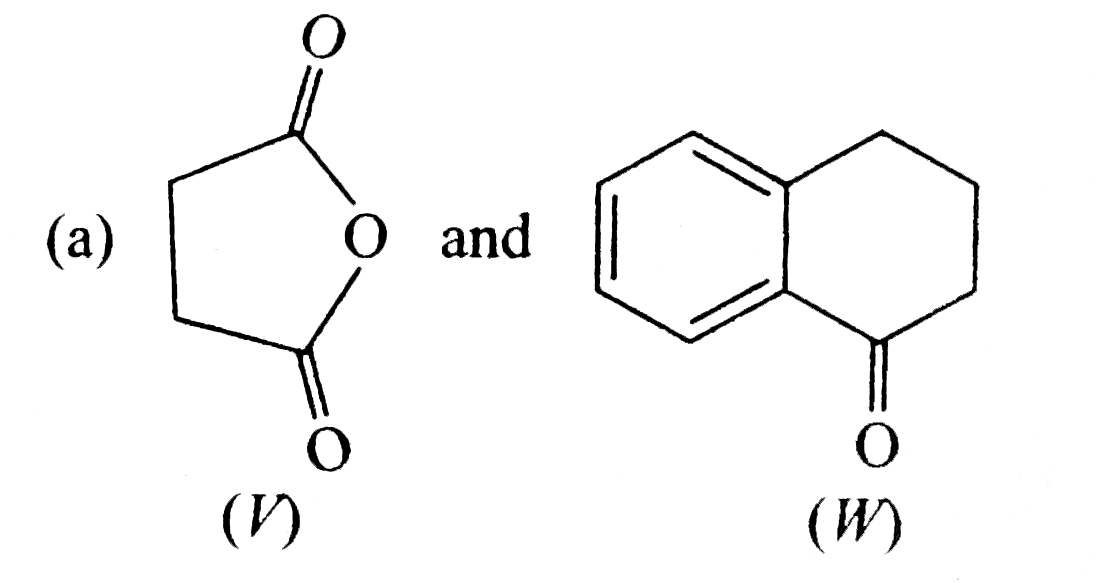P and Q are isomers of dicarboxylic acid C4H4O4. Both decolorize Br2/H2O. On heating, P forms the cyclic anydride.
Upon treatment with dilute alkaline KMnO4, p as well as Q could produce one or more than one from the S,T and U

In the following reaction, sequences V and W are respectively.





The correct Answer is:A
Topper's Solved these Questions
- AROMATIC COMPOUNDS BOOK - RESONANCECHAPTER - AROMATIC COMPOUNDS EXERCISE - PART-II JEE MAIN
19 Videos
- AROMATIC COMPOUNDS BOOK - RESONANCECHAPTER - AROMATIC COMPOUNDS EXERCISE - JEE(MAIN) ONLINE PROBLEM
16 Videos
- AROMATIC COMPOUNDS BOOK - RESONANCECHAPTER - AROMATIC COMPOUNDS EXERCISE - PART IV- COMPREHENSION
14 Videos
- ATOMIC STRUCTUREBOOK - RESONANCECHAPTER - ATOMIC STRUCTUREEXERCISE - PHYSICAL CHEMISTRY(ATOMIC EQUILIBRIUM)
48 Videos
Similar Questions
P and Q are isomers of dicarboxylic acid C4H4O4. Both decolorize Br2/H2O. On heating, P forms the cyclic anydride.
Upon treatment with dilute alkaline KMnO4, p as well as Q could produce one or more than one from the S,T and U

Compounds formed from P and Q are, respectively:
View SolutionA compound X is formed by the reaction of a carboxylic acid C2H4O2 and an alcohol in the presence of a few drops of H2SO4 .The alcohol on oxidation with alkaline KMnO4 followed by acidification gives the same carboxylic acid as used in this reaction .Give the names and structures of :
Alcohol
View Solution
Knowledge Check
P and Q are isomer of dicraboxylic acid C4H4O4 Both decolourixe Br2/H2O. On heating , P forms the cyclic anhydride. Upon treatment with duilute alkaline KMnO4. P as well a Q could produce one or more than one from S,T and U.

In the following reaction sequences V and W are respectively
QH2/Ni−−−→ΔV
 A
A B
B C
C D
D
P and Q are isomers of dicarboxylic acid C4H4O4. Both decolorize Br2/H2O. On heating, P forms the cyclic anydride.
Upon treatment with dilute alkaline KMnO4, p as well as Q could produce one or more than one from the S,T and U

Compounds formed from P and Q are, respectively:AOptically active S and optically active pair (T,U)Boptically inactive S and optically inactive pair (T,U)COptically active pair (T,U) and optically active SDOptically inactive pair (T,U) and optically inactive SP and Q are isomers of dicarboxylic acid C4H4O4. Bothdecolorize Br2/H2O. On heating, P forms the cyclic anhydride. Upon treatment with dilute alkaline KMnO4,P as well as Q could produce one or more than one forms S,T and U.
 Compounds formed from P and Q are, respectivelyAoptically inactive pair (T,U) and optically inactive SBoptically active pair (T,U) and optically active SCoptically inactive S and optically inactive pair (T,U)Doptically active S and optically inactive pair (T,U)
Compounds formed from P and Q are, respectivelyAoptically inactive pair (T,U) and optically inactive SBoptically active pair (T,U) and optically active SCoptically inactive S and optically inactive pair (T,U)Doptically active S and optically inactive pair (T,U)
P4–––+H2O→No reaction
View SolutionP and Q are isomer of dicraboxylic acid C4H4O4 Both decolourixe Br2/H2O. On heating , P forms the cyclic anhydride. Upon treatment with duilute alkaline KMnO4. P as well a Q could produce one or more than one from S,T and U.

Compounds formed P and Q are, respectively
View SolutionP and Q are isomers of dicarboxyhc acid C4H4O4 .Both decolourize Br2/H2O On heating, P forms the cyclic anhydride.
Upon treatment with dilute alkaline KMnO4, P ass well as Q could produce one or more than one from S. T and U.

Compounds formed form P and Q are, respectively.
View SolutionP4–––+H2O→No reaction
View SolutionP4–––+H2O→No reaction
View Solution
